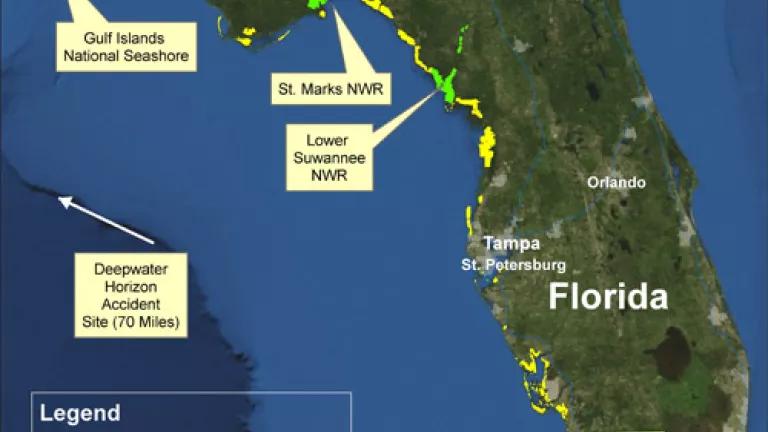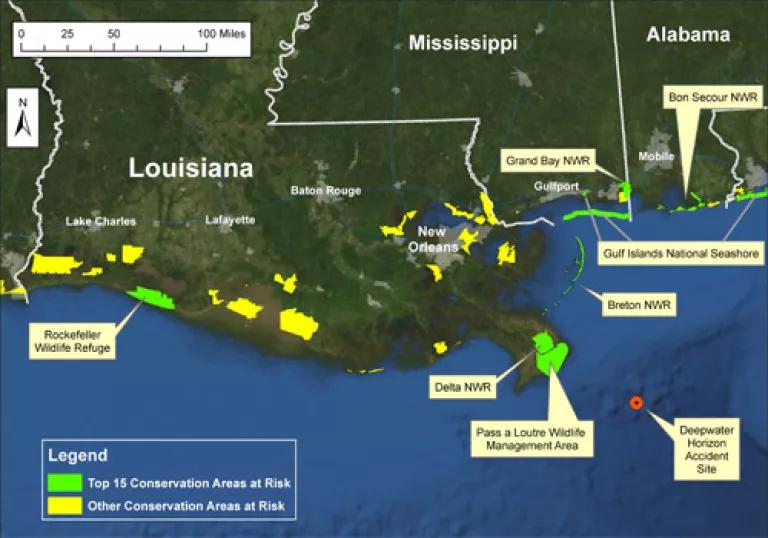
My wife grew up near Santa Barbara, and every time we visit her parents, I’m shocked to see those oil rigs so close to shore. They ruin the view of one America’s most beautiful coastlines. There might have been more of them if it hadn’t been for the spill there in 1969, which created an estimated 800 mile oil slick, saturating beaches and wildlife. That spill helped launch the Environmental movement in the United States.
But the exploded BP well in the Gulf of Mexico is spewing the same amount of oil every day as the total from the Santa Barbara spill, according to some estimates. The folks I’ve spoken to down in the Gulf are calling this “America’s Chernobyl.” They say the true extent of damage from the spill hasn’t been covered by the media.
Well to help draw attention to this catastrophe and the impacts it’s having, we’ve released Special Places at Risk in the Gulf: Effects of the BP Oil Catastrophe along with the Rocky Mountain Climate Organization. The report lists the following 15 top national and state parks and wildlife areas at risk to contamination because of the BP drilling rig explosion. They range from Padre Island National Seashore in Texas to the Everglades National Park in Florida.
You can listen to the press conference here
Here’s our list of the 15 national parks, wildlife refuges and state parks most threatened by the ongoing BP oil spill:
- Gulf Islands National Seashore, Mississippi and Florida
- Padre Island National Seashore, Texas
- Everglades National Park, Florida
- Dry Tortugas National Park, Florida
- Lower Suwanee National Wildlife Refuge, Florida
- Key West National Wildlife Refuge, Florida
- Aransas National Wildlife Refuge, Texas
- Rockefeller Wildlife Refuge, Louisiana
- Delta National Wildlife Refuge, Louisiana
- Pass a Loutre Wildlife Management Area, Louisiana
- Breton National Wildlife Refuge, Louisiana
- Grand Bay National Wildlife Refuge, Mississippi and Alabama
- Bon Secour National Wildlife Refuge, Alabama
- St. Marks National Wildlife Refuge, Florida
- John Pennekamp Coral Reef State Park, Florida


Our report focuses on and documents on just one key aspect of the Gulf of Mexico environment that is at risk to the oil disaster: the protected areas in the region and the valuable resources they are designed to safeguard. There are well over 100 national and state parks, wildlife refuges, and other protected areas in the Gulf and along its coasts.
The special places on our list were chosen to include the best examples of the full range of both the protected public areas and the resources within them that are vulnerable to contamination by the BP disaster. But our list certainly cannot include more than a tiny fraction of what is at stake as oil continues to gush into and spread around the Gulf.
However by highlighting certain special places and what they protect, this report may shed some light on one aspect of the BP disaster: This manifestation of our country’s dangerous over-dependence on fossil fuels threatens much of what Americans hold dear, including special places and unique natural resources in a region of great natural value.
Our report is intended not to raise a useless alarm, but to galvanize action. Short-term action is urgently needed to cut the further flow of oil from the destroyed drilling rig, to block as much as possible the spread of the oil already in the Gulf, to defend the environment from contamination, and to recover affected resources.
Every bit as important is long-term action. The BP oil catastrophe is today’s overwhelming demonstration of the dangers of America’s over-dependence on and over-use of fossil fuels. Besides oil spills, those dangers include emissions of heat-trapping gases that are disrupting our climate, other air pollution that causes deaths and illnesses, high energy costs that undercut our national and personal economies, and even increased risks to our national security.
Among the steps that should be taken to protect the special places profiled in this report and scores of others in the Gulf region are:
- Both immediate and long-term monitoring of the impacts from the oil;
- Determination of the best methods to restore natural resources with as little collateral ecosystem damage as possible;
- The use of mitigation funds from BP and other responsible parties to replace lost habitat, including both restoration of existing and acquisition of new park and refuge lands as was done in the case of the Exxon Valdez oil spill; and
- Presentation of information on this catastrophe, its causes, and its effects to visitors to parks and refuges in the region. This should be an essential part of the role of managers of those conservation units.
As importantly, oil exploration policy and energy policy more generally need to be thoroughly reviewed and reconsidered in light of the startling new facts emerging from the Gulf. We need to take the following actions:
- Impose a moratorium on all new oil activities offshore, and ensure the ground rules for future off-shore drilling reflect the lessons of the Deepwater Horizon. This would mean a halt to new offshore leasing, exploratory drilling and seismic exploration, including the exploratory drilling that is scheduled to begin in the Chukchi and Beaufort Seas in Alaska this summer. The moratorium should remain in effect until the causes of the BP blowout and their ramifications are fully understood and have been addressed, and appropriate new rules and standards can be imposed.
- Initiate an independent investigation that assess the causes of the current spill, how such spills can be avoided in the future, the adequacy of containment and clean-up measures for spills generally, and the implications of these findings for drilling in, or adjacent to sensitive or ecologically important areas. Recommendations should be issued on how to strengthen regulations to prevent spills, to protect sensitive and ecologically important areas, and for criteria to determine whether areas should be excluded from leasing. The moratorium and suspensions called for above should not be lifted before the investigation has been completed.
- A full explanation for the use of more than 500,000 gallons of chemical dispersants to address the spill: why these chemical dispersants are being used as they are, what impact these chemicals have on marine life, and upon what criteria the decision was made to allow their use in this volume and way. The chemicals are untested in deep water, and their use amounts to a giant experiment in our oceans.
Finally, we need to get serious about the best way to produce the oil we use. Expanding offshore drilling could increase U.S. production by less than 300,000 barrels a day by 2030, according to the American Petroleum Institute, which represents the oil companies. But we could get ten times that amount - three million barrels a day - by using carbon dioxide captured from power plant emissions to force out oil stranded in existing domestic wells, according to a March report by Advanced Resources International. And a February analysis by the Environmental Protection Agency shows how we can reduce oil consumption overall by seven million barrels per day.
Ultimately, to protect our special places like National Parks, Seashores and Wildlife Refuges for the enjoyment of this and future generations, Congress needs to pass comprehensive clean energy and climate legislation. The House of Representatives has already passed such legislation and now it is the Senate’s turn to act. These policies would move us away from our dangerous dependence on oil and toward a mix of sustainable and renewable power and fuel. It would reduce heat-trapping gases so that a changed climate and its impacts do not overwhelm our parks, seashores and wildlife refuges. The federal government must take these essential steps:
- Enact comprehensive mandatory limits on global warming pollution to reduce emissions by at least 17% below current levels by 2020 and 80% by 2050. This will deliver the reductions that scientists currently believe are the minimum necessary, and provide businesses the economic certainty needed to make multi-million and multibillion dollar capital investments.
- Overcome barriers to investment in energy efficiency to lower emission reduction costs, starting now.
- Act to accelerate (investment in) the development and deployment of emerging clean energy technologies to lower long-term emission reduction costs.
These steps would help ensure that the lessons of this disaster can be used to secure a better energy and environmental future for ourselves and coming generations.